Astronomy college course/Star (Wikipedia)
Star (Thanks to the Wikipedia editors, who authored the original Wikipedia article; their article is much longer and prints at approximately 34 pages)
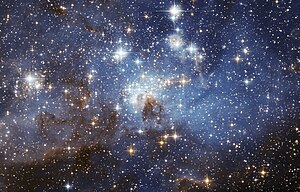


A star is a massive, luminous sphere of plasma held together by its own gravity. The nearest star to Earth is the Sun. Historically, the most prominent stars in the sky were grouped into constellations and asterisms, and the brightest stars gained proper names.
For at least a portion of its life, a star shines due to thermonuclear fusion of hydrogen into helium in its core, releasing energy that traverses the star's interior and then radiates into outer space. Once the hydrogen in the core of a star is nearly exhausted, almost all naturally occurring elements heavier than helium are created by stellar nucleosynthesis during the star's lifetime and, for some stars, by supernova nucleosynthesis when it explodes. The total mass of a star is the principal determinant of its evolution and eventual fate.
Much has been learned about stars from plots of the temperature of many stars against their luminosities, known as a Hertzsprung–Russell (H–R) diagrams. The position of a star on the H-R diagram often allows the age and evolutionary state of a star to be determined.
A star's life begins with the gravitational collapse of a gaseous w:nebula of material composed primarily of hydrogen, along with helium and trace amounts of heavier elements. Once the stellar core is sufficiently dense, hydrogen becomes steadily converted into helium through nuclear fusion, releasing energy in the process.[1] The remainder of the star's interior carries energy away from the core through a combination of radiative and convective processes. The star's internal pressure prevents it from collapsing further under its own gravity. Once the hydrogen fuel at the core is exhausted, a star with at least 0.4 times the mass of the Sun[2] expands to become a red giant, in some cases fusing heavier elements at the core or in shells around the core. The star then evolves into a degenerate form, recycling a portion of its matter into the interstellar environment, where it will contribute to the formation of a new generation of stars with a higher proportion of heavy elements.[3] Meanwhile, the core becomes a stellar remnant: a white dwarf, a neutron star, or (if it is sufficiently massive) a black hole.
Binary and multi-star systems consist of two or more stars that are gravitationally bound as they orbit around each other. When two such stars have a relatively close orbit, their gravitational interaction can have a significant impact on their evolution.[4] Stars can form part of a much larger gravitationally bound structure, such as a star cluster or a galaxy.
Observation history
[edit | edit source]


Historically, stars have been important to civilizations throughout the world. They have been part of religious practices and used for celestial navigation. The Gregorian calendar, currently used nearly everywhere in the world, is a solar calendar based on the angle of the Earth's rotational axis relative to the Sun.
The earliest known star catalogues were compiled by the Kassite Babylonian astronomers of Mesopotamia (ca. 1531–1155 BC).[5] In spite of the apparent immutability of the heavens, Chinese astronomers were aware that new stars could appear.[6] In 185 AD, they were the first to observe and write about a supernova, now known as the SN 185.[7] The SN 1054 supernova, which gave birth to the Crab Nebula, was also observed by Chinese and Islamic astronomers.[8][9][10]
Medieval Islamic astronomers| gave Arabic names to many stars| that are still used today, and they invented numerous astronomical instruments that could compute the positions of the stars. They built the first large observatory research institutes.[11] In 1584 Giordano Bruno suggested that the stars were like the Sun, and may have other planets, possibly even Earth-like, in orbit around them.[12] By the following century, the idea of the stars being the same as the Sun was reaching a consensus among astronomers.

William Herschel was the first astronomer to attempt to determine the distribution of stars in the sky. During the 1780s, he selected 600 small regions of the celestial sphere and counted all the stars in these 600 directions, noting the distribution of apparent magnitude. From this he deduced that the number of stars steadily increased toward one side of the sky, in the direction of the Milky Way core. [13]
The science of stellar spectroscopy was pioneered by Joseph von Fraunhofer and Angelo Secchi. By comparing the spectra of stars to the Sun, they found differences in the strength and number of their absorption lines—the dark lines in a stellar spectra due to the absorption of specific frequencies by the atmosphere. In 1865 Secchi began classifying stars into distinct spectral types. [14] However, the modern version of the stellar classification scheme was developed by Annie J. Cannon during the 1900s.
Other important developments in the 19th century were:
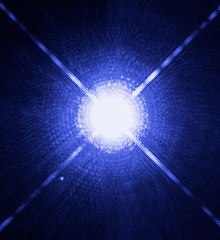
- In 1834, observed changes in the proper motion of w:Sirius led to the discovery of a hidden companion (called Sirius B).
- The first direct measurement of the distance to a star (61 Cygni at 11.4 light-years) was made in 1838 using the parallax technique. These parallax measurements demonstrated the vast separation of the stars in the heavens.
- Edward Pickering discovered the first spectroscopic binary in 1899 when he observed the periodic splitting of the spectral lines of the star [w:[Mizar (star)|Mizar]] in a 104-day period.
- By 1827 the masses of stars could be determined from computation of their orbits .[16]
The 20th century saw even more advances.
- The photograph became a valuable astronomical tool. Karl Schwarzschild discovered that the color of a star, and hence its temperature, could be determined using photographic methods.
- In 1913, the Hertzsprung-Russell diagram was developed, propelling the astrophysical study of stars.
- In 1921 Albert A. Michelson made the first direct measurement of a stellar diameter using an interferometer (However, even today, virtually all stellar diameters are obtained using indirect methods).[17]
Formation and evolution
[edit | edit source]Stars are formed within extended regions of higher density in the interstellar medium, although the density is still lower than the inside of a vacuum chamber. These regions are called molecular clouds and consist mostly of hydrogen, with about 23–28% helium and a few percent heavier elements. One example of such a star-forming region is the [[w:Orion Nebula|].[18] As massive stars are formed from molecular clouds, they powerfully illuminate those clouds. They also ionize the hydrogen, creating an H II region.
All stars spend the majority of their lives as main sequence stars, fueled primarily by the nuclear fusion of hydrogen into helium within their cores. However, stars of different masses have markedly different properties at various stages of their lives. The ultimate fate of more massive stars is different from that of less massive stars, as is their luminosity and the impact they have on their environment. Therefore, stars are often grouped by mass. Very low mass stars with masses below 0.5 solar masses do not enter the asymptotic giant branch (AGB) but evolve directly into white dwarfs. Low mass stars (including the Sun) with a mass above about 0.5 and below about 1.8–2.2 solar masses (depending on composition) do enter the AGB, where they develop a degenerate helium core. Intermediate-mass stars undergo helium fusion and develop a degenerate carbon-oxygen core. Massive stars have a minimum mass of 7–10 solar masses, but this may be as low as 5–6 solar masses. These stars undergo carbon fusion, with their lives ending in a core-collapse supernova explosion.[19]
Protostar formation
[edit | edit source]- See Star formation
The formation of a star begins with gravitational instability within a molecular cloud, as a result of regions of higher density often triggered by shock waves from nearby supernovae (massive stellar explosions), the collision of different molecular clouds, or the collision of galaxies (as in a starburst galaxy). Once a region reaches a sufficient density of matter to satisfy the criteria for Jeans instability, it begins to collapse under its own gravitational force.[20]

Perhaps the easiest way[21] to conceptualize Jeans' Length is to say that a cloud will collapse only if the mass of the cloud, Mcloud is so large that:
The important parameters in this equation are the cloud's radius Rcloud and temperature Tcloud. (The stuff in curly brackets are fundamental constants that we don't care about (Boltzmann constant (kB), universal gravity constant (G), and the average mass of particles in the gas (mp)
As the cloud collapses, individual conglomerations of dense dust and gas form what are known as Bok globules. As a globule collapses and the density increases, the gravitational energy is converted into heat and the temperature rises. When the protostellar cloud has approximately reached the stable condition of hydrostatic equilibrium, a protostar forms at the core.[22] These pre–main sequence stars are often surrounded by a protoplanetary disk and powered mainly by the release of gravitational energy. The period of gravitational contraction lasts about 10–15 million years.
Early stars of less than 2 solar masses are called T Tauri stars, while those with greater mass are Herbig Ae/Be stars. These newly born stars emit jets of gas along their axis of rotation, which may reduce the angular momentum of the collapsing star and result in small patches of nebulosity known as Herbig–Haro objects.[23][24] These jets, in combination with radiation from nearby massive stars, may help to drive away the surrounding cloud from which the star was formed.[25]
Early in their life, T Tauri stars follow the Hayashi track—they contract and decrease in luminosity while remaining at roughly the same temperature. Less massive T Tauri stars follow this track to the main sequence, while more massive stars turn onto the Henyey track.
Main sequence
[edit | edit source]Stars spend about 90% of their lifetime fusing hydrogen into helium in high-temperature and high-pressure reactions near the core. Such stars are said to be on the main sequence and are called dwarf stars. Starting at zero-age main sequence, the proportion of helium in a star's core will steadily increase, the rate of nuclear fusion at the core will slowly increase, as will the star's temperature and luminosity.[26] The Sun, for example, is estimated to have increased in luminosity by about 40% since it reached the main sequence 4.6 billion (4.6 × 109) years ago.[27]
Every star generates a stellar wind of particles that causes a continual outflow of gas into space. For most stars, the mass lost is negligible. The Sun loses 10−14 solar masses every year,[28] or about 0.01% of its total mass over its entire lifespan. However, very massive stars can lose 10−7 to 10−5 solar masses each year, significantly affecting their evolution.[29] Stars that begin with more than 50 solar masses can lose over half their total mass while on the main sequence.[30]
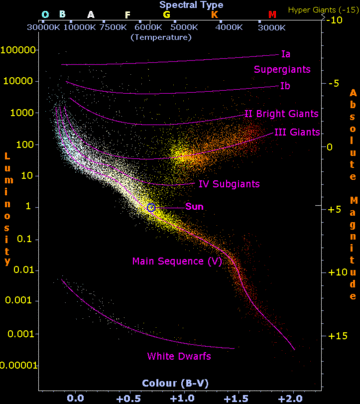
The duration that a star spends on the main sequence depends primarily on the amount of fuel it has to fuse and the rate at which it fuses that fuel, i.e. its initial mass and its luminosity. For the Sun, its life is estimated to be about 10 billion (1010) years. Massive stars consume their fuel very rapidly and are short-lived. Low mass stars consume their fuel very slowly. Stars less massive than 0.25 solar masses, called red dwarfs, are able to fuse nearly all of their mass as fuel while stars of about 1 solar mass can only use about 10% of their mass as fuel. The combination of their slow fuel consumption and relatively large usable fuel supply allows stars about 0.25 times the mass of the Sun to last for about one trillion (1012) years according to stellar evolution calculations, while the least-massive hydrogen-fusing stars (0.08 solar masses) will last for about 12 trillion years.[31] At the end of their lives, red dwarfs simply become dimmer and dimmer.[2] However, since the lifespan of such stars is greater than the current age of the universe (13.8 billion years), no stars under about 0.85 solar masses[32] are expected to have moved off of the main sequence.
Besides mass, the elements heavier than helium can play a significant role in the evolution of stars. In astronomy all elements heavier than helium are considered a "metal", and the chemical concentration of these elements is called the metallicity. The metallicity can influence the duration that a star will burn its fuel, control the formation of magnetic fields[33] and modify the strength of the stellar wind.[34] Older, population II stars have substantially less metallicity than the younger, population I stars due to the composition of the molecular clouds from which they formed. Over time these clouds become increasingly enriched in heavier elements as older stars die and shed portions of their atmospheres.
Post-main sequence
[edit | edit source]As stars of at least 0.4 solar masses[2] exhaust their supply of hydrogen at their core, their outer layers expand greatly and cool to form a red giant. In about 5 billion years, when the Sun enters this phase, it will expand to a maximum radius of roughly 1 astronomical unit (150 million kilometres), 250 times its present size. As a giant, the Sun will lose roughly 30% of its current mass.[27][35]
In a red giant of up to 2.25 solar masses, hydrogen fusion proceeds in a shell surrounding the core.[36] Eventually the core is compressed enough to start helium fusion, and the star now gradually shrinks in radius and its surface temperature increases. For larger stars, the core region transitions directly from fusing hydrogen to fusing helium.[4]
After the star has consumed the helium at the core, fusion continues in a shell around a hot core of carbon and oxygen. The star then follows an evolutionary path that parallels the original red giant phase, but at a higher surface temperature.
Massive stars
[edit | edit source]During their helium-burning phase, very high mass stars with more than nine solar masses expand to form red supergiants. Once this fuel is exhausted at the core, they continue to fuse elements heavier than helium.
The core contracts until the temperature and pressure are sufficient to fuse carbon (see carbon burning process). This process continues, with the successive stages being fueled by neon (see neon burning process), oxygen (see oxygen burning process), and silicon (see silicon burning process). Near the end of the star's life, fusion continues along a series of onion-layer shells within the star. Each shell fuses a different element, with the outermost shell fusing hydrogen; the next shell fusing helium, and so forth.[37]
The final stage is reached when a massive star begins producing iron. Since iron nuclei are more tightly bound than any heavier nuclei, any fusion beyond iron does not produce a net release of energy—the process would, on the contrary, consume energy. Likewise, since they are more tightly bound than all lighter nuclei, energy cannot be released by fission.[36] In relatively old, very massive stars, a large core of inert iron will accumulate in the center of the star. The heavier elements in these stars can work their way to the surface, forming evolved objects known as Wolf-Rayet stars that have a dense stellar wind which sheds the outer atmosphere.
Collapse
[edit | edit source]As a star's core shrinks, the intensity of radiation from that surface increases, creating such radiation pressure on the outer shell of gas that it will push those layers away, forming a planetary nebula. If what remains after the outer atmosphere has been shed is less than 1.4 solar masses, it shrinks to a relatively tiny object about the size of Earth, known as a white dwarf. It is not massive enough for further gravitational compression to take place.[38] The electron-degenerate matter inside a white dwarf is no longer a plasma, even though stars are generally referred to as being spheres of plasma. Eventually, white dwarfs will fade into black dwarfs over a very long period of time.
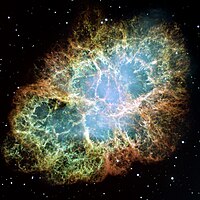
In larger stars, fusion continues until the iron core has grown so large (more than 1.4 solar masses) that it can no longer support its own mass. This core will suddenly collapse as its electrons are driven into its protons, forming neutrons, neutrinos and gamma rays in a burst of electron capture and inverse beta decay. The shockwave formed by this sudden collapse causes the rest of the star to explode in a supernova. Supernovae are so bright that they may briefly outshine the star's entire home galaxy. When they occur within the Milky Way, supernovae have historically been observed by naked-eye observers as "new stars" where none seemingly existed before.[39]
Most of the star's matter is blown away by the supernova explosion (forming nebulae such as the Crab Nebula).[39] What remains will be a neutron star (which sometimes manifests itself as a pulsar or X-ray burster) or, in the case of the largest stars (large enough to leave a remnant greater than roughly 4 solar masses), a black hole.[40] In a neutron star the matter is in a state known as neutron-degenerate matter, with a more exotic form of degenerate matter, QCD matter, possibly present in the core. Within a black hole the matter is in a state that is not currently understood.
The blown-off outer layers of dying stars include heavy elements, which may be recycled during new star formation. These heavy elements allow the formation of rocky planets. The outflow from supernovae and the stellar wind of large stars play an important part in shaping the interstellar medium.[39]
Distribution
[edit | edit source]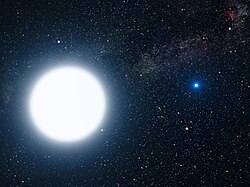
In addition to isolated stars, a multi-star system can consist of two or more gravitationally bound stars that orbit each other. The simplest and most common multi-star system is a binary star, but systems of three or more stars are also found. For reasons of orbital stability, such multi-star systems are often organized into hierarchical sets of binary stars.[41] Larger groups called star clusters also exist. These range from loose stellar associations with only a few stars, up to enormous globular clusters with hundreds of thousands of stars.
It has been a long-held assumption that the majority of stars occur in gravitationally bound, multiple-star systems. This is particularly true for very massive O and B class stars, where 80% of the stars are believed to be part of multiple-star systems. However the proportion of single star systems increases for smaller stars, so that only 25% of red dwarfs are known to have stellar companions. As 85% of all stars are red dwarfs, most stars in the Milky Way are likely single from birth.[42]
Stars are not spread uniformly across the universe, but are normally grouped into galaxies along with interstellar gas and dust. A typical galaxy contains hundreds of billions of stars, and there are more than 100 billion (1011) galaxies in the observable universe.[43] A 2010 star count estimate was 300 sextillion (3 × 1023) in the observable universe.[44] While it is often believed that stars only exist within galaxies, intergalactic stars have been discovered.[45]
The nearest star to the Earth, apart from the Sun, is Proxima Centauri, which is 39.9 trillion kilometres, or 4.2 light-years away. Travelling at the orbital speed of the Space Shuttle (8 kilometres per second—almost 30,000 kilometres per hour), it would take about 150,000 years to get there.[46] Distances like this are typical inside galactic discs, including in the vicinity of the solar system.[47] Stars can be much closer to each other in the centres of galaxies and in globular clusters, or much farther apart in galactic halos.
Due to the relatively vast distances between stars outside the galactic nucleus, collisions between stars are thought to be rare. In denser regions such as the core of globular clusters or the galactic center, collisions can be more common.[48] Such collisions can produce what are known as blue stragglers. These abnormal stars have a higher surface temperature than the other main sequence stars with the same luminosity in the cluster.[49]
Characteristics
[edit | edit source]Almost everything about a star is determined by its initial mass, including essential characteristics such as luminosity and size, as well as its evolution, lifespan, and eventual fate.
Age
[edit | edit source]The more massive the star, the shorter its lifespan, primarily because massive stars have greater pressure on their cores, causing them to burn hydrogen more rapidly. The most massive stars last an average of a few million years, while stars of minimum mass (red dwarfs) burn their fuel very slowly and can last tens to hundreds of billions of years.[50][51]
Chemical composition
[edit | edit source]- See Metallicity and Molecules in stars
| “ | “From a chemist’s point of view, the surface or interior of a star…is boring—there are no molecules there.”--Roald Hoffmann[52] | ” |
When stars form in the present Milky Way galaxy they are composed of about 71% hydrogen and 27% helium,[53] as measured by mass, with a small fraction of heavier elements. Typically the portion of heavy elements is measured in terms of the iron content of the stellar atmosphere, as iron is a common element and its absorption lines are relatively easy to measure. Because the molecular clouds where stars form are steadily enriched by heavier elements, a measurement of the chemical composition of a star serves as a crude indicator if its age.
Diameter
[edit | edit source]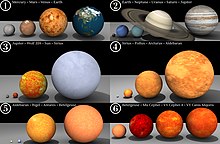
Due to their great distance from the Earth, all stars except the Sun appear to the unaided eye as shining points in the night sky that twinkle because of the effect of the Earth's atmosphere. The Sun is also a star, but it is close enough to the Earth to appear as a disk instead, and to provide daylight. Other than the Sun, the star with the largest apparent size is R Doradus, with an angular diameter of only 0.057 arcseconds.[54]
The disks of most stars are much too small in angular size to be observed with current ground-based optical telescopes, and so interferometer telescopes are required to produce images of these objects. Another technique for measuring the angular size of stars is through occultation. By precisely measuring the drop in brightness of a star as it is occulted by the Moon (or the rise in brightness when it reappears), the star's angular diameter can be computed.[55]
Stars range in size from neutron stars, which vary anywhere from 20 to 40 km (25 mi) in diameter, to supergiants like Betelgeuse in the Orion constellation, which has a diameter approximately 650 times that of the Sun—about 900,000,000 km (559,234,073 mi). Betelgeuse, however, has a much lower density than the Sun.[56]
Kinematics
[edit | edit source]
The motion of a star relative to the Sun can provide useful information about the origin and age of a star, as well as the structure and evolution of the surrounding galaxy. The components of motion of a star consist of the radial velocity toward or away from the Sun, and the traverse angular movement, which is called its proper motion.
Radial velocity is measured by the doppler shift of the star's spectral lines, and is given in units of km/s. The proper motion of a star is determined by precise astrometric measurements in units of milli-arc seconds (mas) per year. By determining the parallax of a star, the proper motion can then be converted into units of velocity. Stars with high rates of proper motion are likely to be relatively close to the Sun, making them good candidates for parallax measurements.[58]
Once both rates of movement are known, the space velocity of the star relative to the Sun or the galaxy can be computed. Among nearby stars, it has been found that younger population I stars have generally lower velocities than older, population II stars. The latter have elliptical orbits that are inclined to the plane of the galaxy.[59] A comparison of the kinematics of nearby stars has also led to the identification of stellar associations. These are most likely groups of stars that share a common point of origin in giant molecular clouds.[60]
Mass
[edit | edit source]One of the most massive stars known is Eta Carinae,[61] which, with 100–150 times as much mass as the Sun, will have a lifespan of only several million years. A study of the Arches cluster suggests that 150 solar masses is the upper limit for stars in the current era of the universe.[62] The reason for this limit is not precisely known, but it is partially due to the Eddington luminosity which defines the maximum amount of luminosity that can pass through the atmosphere of a star without ejecting the gases into space. However, a star named R136a1 in the Large Magellanic Cloud, RMC 136a star cluster has been measured at 265 solar masses, which puts this limit into question.[63] A study determined that stars larger than 150 solar masses in R136 were created through the collision and merger of massive stars in close binary systems, providing a way to sidestep the 150 solar mass limit.[64]
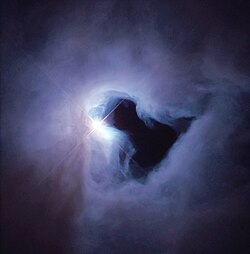
The first stars to form after the Big Bang may have been larger, up to 300 solar masses or more,[65] due to the complete absence of elements heavier than lithium in their composition. This generation of supermassive, population III stars is long extinct, however, and currently only theoretical.
With a mass only 93 times that of Jupiter, AB Doradus C, a companion to AB Doradus A, is the smallest known star undergoing nuclear fusion in its core.[66] For stars with similar metallicity to the Sun, the theoretical minimum mass the star can have, and still undergo fusion at the core, is estimated to be about 75 times the mass of Jupiter.[67][68] When the metallicity is very low, however, a recent study of the faintest stars found that the minimum star size seems to be about 8.3% of the solar mass, or about 87 times the mass of Jupiter.[68][69] Smaller bodies are called brown dwarfs, which occupy a poorly defined grey area between stars and gas giants.
The combination of the radius and the mass of a star determines the surface gravity. Giant stars have a much lower surface gravity than main sequence stars, while the opposite is the case for degenerate, compact stars such as white dwarfs. The surface gravity can influence the appearance of a star's spectrum, with higher gravity causing a broadening of the absorption lines.[70]
Rotation
[edit | edit source]The rotation rate of stars can be determined through spectroscopic measurement, or more exactly determined by tracking the rotation rate of starspots. Young stars can have a rapid rate of rotation greater than 100 km/s at the equator. The B-class star Achernar, for example, has an equatorial rotation velocity of about 225 km/s or greater, causing its equator to be slung outward and giving it an equatorial diameter that is more than 50% larger than the distance between the poles. This rate of rotation is just below the critical velocity of 300 km/s where the star would break apart.[71] By contrast, the Sun only rotates once every 25 – 35 days, with an equatorial velocity of 1.994 km/s. The star's magnetic field and the stellar wind serve to slow a main sequence star's rate of rotation by a significant amount as it evolves on the main sequence.[72]
Degenerate stars have contracted into a compact mass, resulting in a rapid rate of rotation. However they have relatively low rates of rotation compared to what would be expected by conservation of angular momentum—the tendency of a rotating body to compensate for a contraction in size by increasing its rate of spin. A large portion of the star's angular momentum is dissipated as a result of mass loss through the stellar wind.[73] In spite of this, the rate of rotation for a pulsar can be very rapid. The pulsar at the heart of the Crab nebula, for example, rotates 30 times per second.[74] The rotation rate of the pulsar will gradually slow due to the emission of radiation.
Temperature
[edit | edit source]The surface temperature of a main sequence star is determined by the rate of energy production at the core and by its radius, and is often estimated from the star's color index.[75] The temperature is normally given as the effective temperature, which is the temperature of an idealized black body that radiates its energy at the same luminosity per surface area as the star. Note that the effective temperature is only a representative value, as the temperature increases toward the core.[76] The temperature in the core region of a star is several million kelvins.[77]
The stellar temperature will determine the rate of ionization of various elements, resulting in characteristic absorption lines in the spectrum. The surface temperature of a star, along with its visual absolute magnitude and absorption features, is used to classify a star (see classification below).[70]
Massive main sequence stars can have surface temperatures of 50,000 K. Smaller stars such as the Sun have surface temperatures of a few thousand K. Red giants have relatively low surface temperatures of about 3,600 K; but they also have a high luminosity due to their large exterior surface area.[78]
Radiation
[edit | edit source]The energy produced by stars, as a product of nuclear fusion, radiates into space as both electromagnetic radiation and particle radiation. The particle radiation emitted by a star is manifested as the stellar wind,[79] which streams from the outer layers as free protons, and electrically charged alpha, and beta particles. Although almost massless there also exists a steady stream of neutrinos emanating from the star's core.
The production of energy at the core is the reason stars shine so brightly: every time two or more atomic nuclei fuse together to form a single atomic nucleus of a new heavier element, gamma ray photons are released from the nuclear fusion product. This energy is converted to other forms of electromagnetic energy of lower frequency, such as visible light, by the time it reaches the star's outer layers.
The color of a star, as determined by the most intense frequency of the visible light, depends on the temperature of the star's outer layers, including its photosphere.[80] Besides visible light, stars also emit forms of electromagnetic radiation that are invisible to the human eye. In fact, stellar electromagnetic radiation spans the entire electromagnetic spectrum, from the longest wavelengths of radio waves through infrared, visible light, ultraviolet, to the shortest of X-rays, and gamma rays. From the standpoint of total energy emitted by a star, not all components of stellar electromagnetic radiation are significant, but all frequencies provide insight into the star's physics.
Using the stellar spectrum, astronomers can also determine the surface temperature, surface gravity, metallicity and rotational velocity of a star. If the distance of the star is known, such as by measuring the parallax, then the luminosity of the star can be derived. The mass, radius, surface gravity, and rotation period can then be estimated based on stellar models. (Mass can be calculated for stars in binary systems by measuring their orbital velocities and distances. Gravitational microlensing has been used to measure the mass of a single star.[81]) With these parameters, astronomers can also estimate the age of the star.[82]
Luminosity
[edit | edit source]The luminosity of a star is the amount of light and other forms of radiant energy it radiates per unit of time. It has units of power. The luminosity of a star is determined by the radius and the surface temperature. However, many stars do not radiate a uniform flux (the amount of energy radiated per unit area) across their entire surface. The rapidly rotating star Vega, for example, has a higher energy flux at its poles than along its equator.[83]
Surface patches with a lower temperature and luminosity than average are known as starspots. Small, dwarf stars such as our Sun generally have essentially featureless disks with only small starspots. Larger, giant stars have much larger, more obvious starspots,[84] and they also exhibit strong stellar limb darkening. That is, the brightness decreases towards the edge of the stellar disk.[85] Red dwarf flare stars such as UV Ceti may also possess prominent starspot features.[86]
Classification
[edit | edit source]| Class | Temperature | Sample star |
|---|---|---|
| O | 33,000 K or more | Zeta Ophiuchi |
| B | 10,500–30,000 K | Rigel |
| A | 7,500–10,000 K | Altair |
| F | 6,000–7,200 K | Procyon A |
| G | 5,500–6,000 K | Sun |
| K | 4,000–5,250 K | Epsilon Indi |
| M | 2,600–3,850 K | Proxima Centauri |
The current stellar classification system originated in the early 20th century, when stars were classified from A to Q based on the strength of the hydrogen line.[88] It was not known at the time that the major influence on the line strength was temperature; the hydrogen line strength reaches a peak at over 9000 K, and is weaker at both hotter and cooler temperatures. When the classifications were reordered by temperature, it more closely resembled the modern scheme.[89]
Stars are given a single-letter classification according to their spectra, ranging from type O, which are very hot, to M, which are so cool that molecules may form in their atmospheres. The main classifications in order of decreasing surface temperature are: O, B, A, F, G, K, and M. A variety of rare spectral types have special classifications. The most common of these are types L and T, which classify the coldest low-mass stars and brown dwarfs. Each letter has 10 sub-divisions, numbered from 0 to 9, in order of decreasing temperature. However, this system breaks down at extreme high temperatures: class O0 and O1 stars may not exist.[90]
In addition, stars may be classified by the luminosity effects found in their spectral lines, which correspond to their spatial size and is determined by the surface gravity. These range from 0 (hypergiants) through III (giants) to V (main sequence dwarfs); some authors add VII (white dwarfs). Most stars belong to the main sequence, which consists of ordinary hydrogen-burning stars. These fall along a narrow, diagonal band when graphed according to their absolute magnitude and spectral type.[90] The Sun is a main sequence G2V yellow dwarf of intermediate temperature and ordinary size.
Additional nomenclature, in the form of lower-case letters, can follow the spectral type to indicate peculiar features of the spectrum. For example, an "e" can indicate the presence of emission lines; "m" represents unusually strong levels of metals, and "var" can mean variations in the spectral type.[90]
White dwarf stars have their own class that begins with the letter D. This is further sub-divided into the classes DA, DB, DC, DO, DZ, and DQ, depending on the types of prominent lines found in the spectrum. This is followed by a numerical value that indicates the temperature index.[91]
Variable stars
[edit | edit source]
Variable stars have periodic or random changes in luminosity because of intrinsic or extrinsic properties. Of the intrinsically variable stars, the primary types can be subdivided into three principal groups.
During their stellar evolution, some stars pass through phases where they can become pulsating variables. Pulsating variable stars vary in radius and luminosity over time, expanding and contracting with periods ranging from minutes to years, depending on the size of the star. This category includes Cepheid and cepheid-like stars, and long-period variables such as Mira.[92]
Eruptive variables are stars that experience sudden increases in luminosity because of flares or mass ejection events.[92] This group includes protostars, Wolf-Rayet stars, and Flare stars, as well as giant and supergiant stars.
Cataclysmic or explosive variable stars are those that undergo a dramatic change in their properties. This group includes novae and supernovae. A binary star system that includes a nearby white dwarf can produce certain types of these spectacular stellar explosions, including the nova and a Type 1a supernova.[4] The explosion is created when the white dwarf accretes hydrogen from the companion star, building up mass until the hydrogen undergoes fusion.[93] Some novae are also recurrent, having periodic outbursts of moderate amplitude.[92]
Stars can also vary in luminosity because of extrinsic factors, such as eclipsing binaries, as well as rotating stars that produce extreme starspots.[92] A notable example of an eclipsing binary is Algol, which regularly varies in magnitude from 2.3 to 3.5 over a period of 2.87 days.
Structure
[edit | edit source]
The interior of a stable star is in a state of hydrostatic equilibrium: the forces on any small volume almost exactly counterbalance each other. The balanced forces are inward gravitational force and an outward force due to the pressure gradient within the star. The pressure gradient is established by the temperature gradient of the plasma; the outer part of the star is cooler than the core. The temperature at the core of a main sequence or giant star is at least on the order of 107 K. The resulting temperature and pressure at the hydrogen-burning core of a main sequence star are sufficient for nuclear fusion to occur and for sufficient energy to be produced to prevent further collapse of the star.[94][95]
As atomic nuclei are fused in the core, they emit energy in the form of gamma rays. These photons interact with the surrounding plasma, adding to the thermal energy at the core. Stars on the main sequence convert hydrogen into helium, creating a slowly but steadily increasing proportion of helium in the core. Eventually the helium content becomes predominant and energy production ceases at the core. Instead, for stars of more than 0.4 solar masses, fusion occurs in a slowly expanding shell around the degenerate helium core.[96]
In addition to hydrostatic equilibrium, the interior of a stable star will also maintain an energy balance of thermal equilibrium. There is a radial temperature gradient throughout the interior that results in a flux of energy flowing toward the exterior. The outgoing flux of energy leaving any layer within the star will exactly match the incoming flux from below.
The radiation zone is the region within the stellar interior where radiative transfer is sufficiently efficient to maintain the flux of energy. In this region the plasma will not be perturbed and any mass motions will die out. If this is not the case, however, then the plasma becomes unstable and convection will occur, forming a convection zone. This can occur, for example, in regions where very high energy fluxes occur, such as near the core or in areas with high opacity as in the outer envelope.[95]
The occurrence of convection in the outer envelope of a main sequence star depends on the mass. Stars with several times the mass of the Sun have a convection zone deep within the interior and a radiative zone in the outer layers. Smaller stars such as the Sun are just the opposite, with the convective zone located in the outer layers.[97] Red dwarf stars with less than 0.4 solar masses are convective throughout, which prevents the accumulation of a helium core.[2] For most stars the convective zones will also vary over time as the star ages and the constitution of the interior is modified.[95]
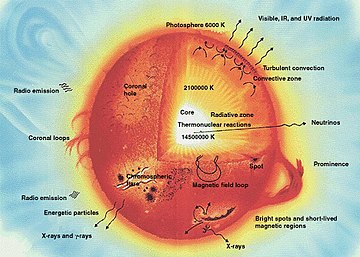
The portion of a star that is visible to an observer is called the photosphere. This is the layer at which the plasma of the star becomes transparent to photons of light. From here, the energy generated at the core becomes free to propagate out into space. It is within the photosphere that sun spots, or regions of lower than average temperature, appear.
Above the level of the photosphere is the stellar atmosphere. In a main sequence star such as the Sun, the lowest level of the atmosphere is the thin chromosphere region, where spicules appear and stellar flares begin. This is surrounded by a transition region, where the temperature rapidly increases within a distance of only 100 km (62 mi). Beyond this is the corona, a volume of super-heated plasma that can extend outward to several million kilometres.[98] The existence of a corona appears to be dependent on a convective zone in the outer layers of the star.[97] Despite its high temperature, the corona emits very little light. The corona region of the Sun is normally only visible during a solar eclipse.
From the corona, a stellar wind of plasma particles expands outward from the star, propagating until it interacts with the interstellar medium. For the Sun, the influence of its solar wind extends throughout the bubble-shaped region of the heliosphere.[99]
Nuclear fusion reaction pathways
[edit | edit source]A variety of different nuclear fusion reactions take place inside the cores of stars, depending upon their mass and composition, as part of stellar nucleosynthesis. The net mass of the fused atomic nuclei is smaller than the sum of the constituents. This lost mass is released as electromagnetic energy, according to the mass-energy equivalence relationship E = mc2.[1]
The hydrogen fusion process is temperature-sensitive, so a moderate increase in the core temperature will result in a significant increase in the fusion rate. As a result the core temperature of main sequence stars only varies from 4 million kelvin for a small M-class star to 40 million kelvin for a massive O-class star.[77]
In the Sun, with a 10-million-kelvin core, hydrogen fuses to form helium in the proton-proton chain reaction:[100]
- 41H → 22H + 2e+ + 2νe (4.0 MeV + 1.0 MeV)
- 21H + 22H → 23He + 2γ (5.5 MeV)
- 23He → 4He + 21H (12.9 MeV)
These reactions result in the overall reaction:
- 41H → 4He + 2e+ + 2γ + 2νe (26.7 MeV)
where e+ is a positron, γ is a gamma ray photon, νe is a neutrino, and H and He are isotopes of hydrogen and helium, respectively. The energy released by this reaction is in millions of electron volts, which is actually only a tiny amount of energy. However enormous numbers of these reactions occur constantly, producing all the energy necessary to sustain the star's radiation output.
| Element | Solar masses |
|---|---|
| Hydrogen | 0.01 |
| Helium | 0.4 |
| Carbon | 5[101] |
| Neon | 8 |
In more massive stars, helium is produced in a cycle of reactions catalyzed by carbon—the carbon-nitrogen-oxygen cycle.[100]
In evolved stars with cores at 100 million kelvin and masses between 0.5 and 10 solar masses, helium can be transformed into carbon in the triple-alpha process that uses the intermediate element beryllium:[100]
For an overall reaction of:
- 34He → 12C + γ + 7.2 MeV
In massive stars, heavier elements can also be burned in a contracting core through the neon burning process and oxygen burning process. The final stage in the stellar nucleosynthesis process is the silicon burning process that results in the production of the stable isotope iron-56. Fusion can not proceed any further except through an endothermic process, and so further energy can only be produced through gravitational collapse.[100]
The example below shows the amount of time required for a star of 20 solar masses to consume all of its nuclear fuel. As an O-class main sequence star, it would be 8 times the solar radius and 62,000 times the Sun's luminosity.[102]
| Fuel material |
Temperature (million kelvins) |
Density (kg/cm3) |
Burn duration (τ in years) |
|---|---|---|---|
| H | 37 | 0.0045 | 8.1 million |
| He | 188 | 0.97 | 1.2 million |
| C | 870 | 170 | 976 |
| Ne | 1,570 | 3,100 | 0.6 |
| O | 1,980 | 5,550 | 1.25 |
| S/Si | 3,340 | 33,400 | 0.0315[103] |
- ↑ 1.0 1.1 Bahcall, John N. (June 29, 2000). "How the Sun Shines". Nobel Foundation. Retrieved 2006-08-30.
- ↑ 2.0 2.1 2.2 2.3 Richmond, Michael. "Late stages of evolution for low-mass stars". Rochester Institute of Technology. Retrieved 2006-08-04.
- ↑ "Stellar Evolution & Death". NASA Observatorium. Archived from the original on 2008-02-10. Retrieved 2006-06-08.
- ↑ 4.0 4.1 4.2 Iben, Icko, Jr. (1991). "Single and binary star evolution". Astrophysical Journal Supplement Series 76: 55–114. doi:10.1086/191565.
- ↑ North, John (1995). The Norton History of Astronomy and Cosmology. New York and London: W.W. Norton & Company. pp. 30–31. ISBN 0-393-03656-1.
- ↑ Clark, D. H.; Stephenson, F. R. (June 29, 1981). The Historical Supernovae. Cambridge, England: Dordrecht, D. Reidel Publishing Co. pp. 355–370. Bibcode:1982sscr.conf..355C.
{{cite conference}}: Unknown parameter|booktitle=ignored (help) - ↑ Zhao, Fu-Yuan; Strom, R. G.; Jiang, Shi-Yang (2006). "The Guest Star of AD185 Must Have Been a Supernova". Chinese Journal of Astronomy and Astrophysics 6 (5): 635–640. doi:10.1088/1009-9271/6/5/17.
- ↑ Frommert, Hartmut; Kronberg, Christine (August 30, 2006). "Supernova 1054 – Creation of the Crab Nebula". SEDS. University of Arizona.
- ↑ Duyvendak, J. J. L. (April 1942). "Further Data Bearing on the Identification of the Crab Nebula with the Supernova of 1054 A.D. Part I. The Ancient Oriental Chronicles". Publications of the Astronomical Society of the Pacific 54 (318): 91–94. doi:10.1086/125409.
Mayall, N. U.; Oort, Jan Hendrik (April 1942). "Further Data Bearing on the Identification of the Crab Nebula with the Supernova of 1054 A.D. Part II. The Astronomical Aspects". Publications of the Astronomical Society of the Pacific 54 (318): 95–104. doi:10.1086/125410. - ↑ Brecher, K. et al. (1983). "Ancient records and the Crab Nebula supernova". The Observatory 103: 106–113.
- ↑ Kennedy, Edward S. (1962). "Review: The Observatory in Islam and Its Place in the General History of the Observatory by Aydin Sayili". Isis 53 (2): 237–239. doi:10.1086/349558.
- ↑ Drake, Stephen A. (August 17, 2006). "A Brief History of High-Energy (X-ray & Gamma-Ray) Astronomy". NASA HEASARC. Retrieved 2006-08-24.
- ↑ Proctor, Richard A. (1870). "Are any of the nebulæ star-systems?". Nature 1 (13): 331–333. doi:10.1038/001331a0. http://digicoll.library.wisc.edu/cgi-bin/HistSciTech/HistSciTech-idx?type=div&did=HISTSCITECH.0012.0052.0005&isize=M.
- ↑ MacDonnell, Joseph. "Angelo Secchi, S.J. (1818–1878) the Father of Astrophysics". Fairfield University. Archived from the original on 2011-07-21. Retrieved 2006-10-02.
- ↑ Cite error: Invalid
<ref>tag; no text was provided for refs namedHubble2005 - ↑ Aitken, Robert G. (1964). The Binary Stars. New York: Dover Publications Inc.. p. 66. ISBN 0-486-61102-7.
- ↑ Michelson, A. A.; Pease, F. G. (1921). "Measurement of the diameter of Alpha Orionis with the interferometer". Astrophysical Journal 53: 249–259. doi:10.1086/142603.
- ↑ Woodward, P. R. (1978). "Theoretical models of star formation". Annual review of astronomy and astrophysics 16 (1): 555–584. doi:10.1146/annurev.aa.16.090178.003011.
- ↑ Kwok, Sun (2000). The origin and evolution of planetary nebulae. Cambridge astrophysics series. 33. Cambridge University Press. pp. 103–104. ISBN 0-521-62313-8.
- ↑ Smith, Michael David (2004). The Origin of Stars. Imperial College Press. pp. 57–68. ISBN 1-86094-501-5.
- ↑ http://www-star.st-and.ac.uk/~kw25/teaching/stars/STRUC5.pdf
- ↑ Seligman, Courtney. "Slow Contraction of Protostellar Cloud". Self-published. Archived from the original on 2008-06-23. Retrieved 2006-09-05.
- ↑ Bally, J.; Morse, J.; Reipurth, B. (1996). Benvenuti, Piero; Macchetto, F. D.; Schreier, Ethan J. (eds.). The Birth of Stars: Herbig-Haro Jets, Accretion and Proto-Planetary Disks. Space Telescope Science Institute. p. 491. Bibcode:1996swhs.conf..491B.
{{cite conference}}: Unknown parameter|booktitle=ignored (help) - ↑ Smith, Michael David (2004). The origin of stars. Imperial College Press. p. 176. ISBN 1-86094-501-5.
- ↑ Megeath, Tom (May 11, 2010). "Herschel finds a hole in space". ESA. Retrieved 2010-05-17.
- ↑ Mengel, J. G. et al. (1979). "Stellar evolution from the zero-age main sequence". Astrophysical Journal Supplement Series 40: 733–791. doi:10.1086/190603.
- ↑ 27.0 27.1 Sackmann, I. J.; Boothroyd, A. I.; Kraemer, K. E. (1993). "Our Sun. III. Present and Future". Astrophysical Journal 418: 457. doi:10.1086/173407.
- ↑ Wood, B. E. et al. (2002). "Measured Mass-Loss Rates of Solar-like Stars as a Function of Age and Activity". The Astrophysical Journal 574 (1): 412–425. doi:10.1086/340797.
- ↑ de Loore, C.; de Greve, J. P.; Lamers, H. J. G. L. M. (1977). "Evolution of massive stars with mass loss by stellar wind". Astronomy and Astrophysics 61 (2): 251–259.
- ↑ "The evolution of stars between 50 and 100 times the mass of the Sun". Royal Greenwich Observatory. Retrieved 2006-09-07.
- ↑ Adams, Fred C.; Laughlin, Gregory; Graves, Genevieve J. M. Red Dwarfs and the End of the Main Sequence (PDF). Revista Mexicana de Astronomía y Astrofísica. pp. 46–49. Retrieved 2008-06-24.
{{cite conference}}: Unknown parameter|booktitle=ignored (help) - ↑ "Main Sequence Lifetime". Swinburne Astronomy Online Encyclopedia of Astronomy. Swinburne University of Technology.
- ↑ Pizzolato, N. et al. (2001). "Subphotospheric convection and magnetic activity dependence on metallicity and age: Models and tests". Astronomy & Astrophysics 373 (2): 597–607. doi:10.1051/0004-6361:20010626.
- ↑ "Mass loss and Evolution". UCL Astrophysics Group. June 18, 2004. Archived from the original on 2004-11-22. Retrieved 2006-08-26.
- ↑ Schröder, K.-P.; Smith, Robert Connon (2008). "Distant future of the Sun and Earth revisited". Monthly Notices of the Royal Astronomical Society 386 (1): 155. doi:10.1111/j.1365-2966.2008.13022.x. See also Palmer, Jason (February 22, 2008). "Hope dims that Earth will survive Sun's death". NewScientist.com news service. Retrieved 2008-03-24.
- ↑ 36.0 36.1 Hinshaw, Gary (August 23, 2006). "The Life and Death of Stars". NASA WMAP Mission. Retrieved 2006-09-01.
- ↑ "What is a star?". Royal Greenwich Observatory. Retrieved 2006-09-07.
- ↑ Liebert, J. (1980). "White dwarf stars". Annual review of astronomy and astrophysics 18 (2): 363–398. doi:10.1146/annurev.aa.18.090180.002051.
- ↑ 39.0 39.1 39.2 "Introduction to Supernova Remnants". Goddard Space Flight Center. April 6, 2006. Retrieved 2006-07-16.
- ↑ Fryer, C. L. (2003). "Black-hole formation from stellar collapse". Classical and Quantum Gravity 20 (10): S73–S80. doi:10.1088/0264-9381/20/10/309.
- ↑ Szebehely, Victor G.; Curran, Richard B. (1985). Stability of the Solar System and Its Minor Natural and Artificial Bodies. Springer. ISBN 90-277-2046-0.
- ↑ "Most Milky Way Stars Are Single" (Press release). Harvard-Smithsonian Center for Astrophysics. January 30, 2006. Retrieved 2006-07-16.
- ↑ "What is a galaxy? How many stars in a galaxy / the Universe?". Royal Greenwich Observatory. Retrieved 2006-07-18.
- ↑ Borenstein, Seth (December 1, 2010). "Universe's Star Count Could Triple". CBS News. Retrieved 2011-07-14.
- ↑ "Hubble Finds Intergalactic Stars". Hubble News Desk. January 14, 1997. Retrieved 2006-11-06.
- ↑ 3.99 × 1013 km / (3 × 104 km/h × 24 × 365.25) = 1.5 × 105 years.
- ↑ Holmberg, J.; Flynn, C. (2000). "The local density of matter mapped by Hipparcos". Monthly Notices of the Royal Astronomical Society 313 (2): 209–216. doi:10.1046/j.1365-8711.2000.02905.x.
- ↑ "Astronomers: Star collisions are rampant, catastrophic". CNN News. June 2, 2000. Retrieved 2014-01-21.
- ↑ Lombardi, Jr., J. C. et al. (2002). "Stellar Collisions and the Interior Structure of Blue Stragglers". The Astrophysical Journal 568 (2): 939–953. doi:10.1086/339060.
- ↑ Naftilan, S. A.; Stetson, P. B. (July 13, 2006). "How do scientists determine the ages of stars? Is the technique really accurate enough to use it to verify the age of the universe?". Scientific American. Retrieved 2007-05-11.
- ↑ Laughlin, G.; Bodenheimer, P.; Adams, F. C. (1997). "The End of the Main Sequence". The Astrophysical Journal 482 (1): 420–432. doi:10.1086/304125.
- ↑ Stellar Molecules » American Scientist
- ↑ Irwin, Judith A. (2007). Astrophysics: Decoding the Cosmos. John Wiley and Sons. p. 78. ISBN 0-470-01306-0.
- ↑ "The Biggest Star in the Sky". ESO. March 11, 1997. Retrieved 2006-07-10.
- ↑ Ragland, S.; Chandrasekhar, T.; Ashok, N. M. (1995). "Angular Diameter of Carbon Star Tx-Piscium from Lunar Occultation Observations in the Near Infrared". Journal of Astrophysics and Astronomy 16: 332.
- ↑ Davis, Kate (December 1, 2000). "Variable Star of the Month—December, 2000: Alpha Orionis". AAVSO. Archived from the original on 2006-07-12. Retrieved 2006-08-13.
- ↑ Loktin, A. V. (September 2006). "Kinematics of stars in the Pleiades open cluster". Astronomy Reports 50 (9): 714–721. doi:10.1134/S1063772906090058.
- ↑ "Hipparcos: High Proper Motion Stars". ESA. September 10, 1999. Retrieved 2006-10-10.
- ↑ Johnson, Hugh M. (1957). "The Kinematics and Evolution of Population I Stars". Publications of the Astronomical Society of the Pacific 69 (406): 54. doi:10.1086/127012.
- ↑ Elmegreen, B.; Efremov, Y. N. (1999). "The Formation of Star Clusters". American Scientist 86 (3): 264. doi:10.1511/1998.3.264. Archived from the original on March 23, 2005. http://web.archive.org/web/20050323072521/http://www.americanscientist.org/template/AssetDetail/assetid/15714/page/1. Retrieved 2006-08-23.
- ↑ Smith, Nathan (1998). "The Behemoth Eta Carinae: A Repeat Offender". Mercury Magazine (Astronomical Society of the Pacific) 27: 20. http://www.astrosociety.org/pubs/mercury/9804/eta.html. Retrieved 2006-08-13.
- ↑ "NASA's Hubble Weighs in on the Heaviest Stars in the Galaxy". NASA News. March 3, 2005. Retrieved 2006-08-04.
- ↑ "Stars Just Got Bigger". European Southern Observatory. July 21, 2010. Retrieved 2010-07-24.
- ↑ Wolchover, Natalie (August 7, 2012). "Mystery of the 'Monster Stars' Solved: It Was a Monster Mash". LiveScience.com.
- ↑ "Ferreting Out The First Stars". Harvard-Smithsonian Center for Astrophysics. September 22, 2005. Retrieved 2006-09-05.
- ↑ "Weighing the Smallest Stars". ESO. January 1, 2005. Retrieved 2006-08-13.
- ↑ Boss, Alan (April 3, 2001). "Are They Planets or What?". Carnegie Institution of Washington. Archived from the original on 2006-09-28. Retrieved 2006-06-08.
- ↑ 68.0 68.1 Shiga, David (August 17, 2006). "Mass cut-off between stars and brown dwarfs revealed". New Scientist. Archived from the original on 2006-11-14. Retrieved 2006-08-23.
- ↑ Leadbeater, Elli (August 18, 2006). "Hubble glimpses faintest stars". BBC. Retrieved 2006-08-22.
- ↑ 70.0 70.1 Cite error: Invalid
<ref>tag; no text was provided for refs namednew cosmos - ↑ "Flattest Star Ever Seen". ESO. June 11, 2003. Retrieved 2006-10-03.
- ↑ Fitzpatrick, Richard (February 13, 2006). "Introduction to Plasma Physics: A graduate course". The University of Texas at Austin. Archived from the original on 2010-01-04. Retrieved 2006-10-04.
- ↑ Villata, Massimo (1992). "Angular momentum loss by a stellar wind and rotational velocities of white dwarfs". Monthly Notices of the Royal Astronomical Society 257 (3): 450–454.
- ↑ "A History of the Crab Nebula". ESO. May 30, 1996. Retrieved 2006-10-03.
- ↑ Strobel, Nick (August 20, 2007). "Properties of Stars: Color and Temperature". Astronomy Notes. Primis/McGraw-Hill, Inc. Archived from the original on 2007-06-26. Retrieved 2007-10-09.
- ↑ Seligman, Courtney. "Review of Heat Flow Inside Stars". Self-published. Retrieved 2007-07-05.
- ↑ 77.0 77.1 "Main Sequence Stars". The Astrophysics Spectator. February 16, 2005. Retrieved 2006-10-10.
- ↑ Zeilik, Michael A.; Gregory, Stephan A. (1998). Introductory Astronomy & Astrophysics (4th ed.). Saunders College Publishing. p. 321. ISBN 0-03-006228-4.
- ↑ Koppes, Steve (June 20, 2003). "University of Chicago physicist receives Kyoto Prize for lifetime achievements in science". The University of Chicago News Office. Retrieved 2012-06-15.
- ↑ "The Colour of Stars". Australian Telescope Outreach and Education. Retrieved 2006-08-13.
- ↑ "Astronomers Measure Mass of a Single Star—First Since the Sun". Hubble News Desk. July 15, 2004. Retrieved 2006-05-24.
- ↑ Garnett, D. R.; Kobulnicky, H. A. (2000). "Distance Dependence in the Solar Neighborhood Age-Metallicity Relation". The Astrophysical Journal 532 (2): 1192–1196. doi:10.1086/308617.
- ↑ Staff (January 10, 2006). "Rapidly Spinning Star Vega has Cool Dark Equator". National Optical Astronomy Observatory. Retrieved 2007-11-18.
- ↑ Michelson, A. A.; Pease, F. G. (2005). "Starspots: A Key to the Stellar Dynamo". Living Reviews in Solar Physics (Max Planck Society). http://solarphysics.livingreviews.org/Articles/lrsp-2005-8/.
- ↑ Manduca, A.; Bell, R. A.; Gustafsson, B. (1977). "Limb darkening coefficients for late-type giant model atmospheres". Astronomy and Astrophysics 61 (6): 809–813.
- ↑ Chugainov, P. F. (1971). "On the Cause of Periodic Light Variations of Some Red Dwarf Stars". Information Bulletin on Variable Stars 520: 1–3.
- ↑ Smith, Gene (April 16, 1999). "Stellar Spectra". University of California, San Diego. Retrieved 2006-10-12.
- ↑ Fowler, A. (1891–2). "The Draper Catalogue of Stellar Spectra". Nature 45: 427–8. doi:10.1038/045427a0.
- ↑ Jaschek, Carlos; Jaschek, Mercedes (1990). The Classification of Stars. Cambridge University Press. pp. 31–48. ISBN 0-521-38996-8.
- ↑ 90.0 90.1 90.2 MacRobert, Alan M. "The Spectral Types of Stars". Sky and Telescope. Retrieved 2006-07-19.
- ↑ "White Dwarf (wd) Stars". White Dwarf Research Corporation. Archived from the original on 2009-10-08. Retrieved 2006-07-19.
- ↑ 92.0 92.1 92.2 92.3 "Types of Variable". AAVSO. May 11, 2010. Retrieved 2010-08-20.
- ↑ "Cataclysmic Variables". NASA Goddard Space Flight Center. 2004-11-01. Retrieved 2006-06-08.
- ↑ Hansen, Carl J.; Kawaler, Steven D.; Trimble, Virginia (2004). Stellar Interiors. Springer. pp. 32–33. ISBN 0-387-20089-4.
- ↑ 95.0 95.1 95.2 Schwarzschild, Martin (1958). Structure and Evolution of the Stars. Princeton University Press. ISBN 0-691-08044-5.
- ↑ "Formation of the High Mass Elements". Smoot Group. Retrieved 2006-07-11.
- ↑ 97.0 97.1 "What is a Star?". NASA. 2006-09-01. Retrieved 2006-07-11.
- ↑ "The Glory of a Nearby Star: Optical Light from a Hot Stellar Corona Detected with the VLT" (Press release). ESO. August 1, 2001. Retrieved 2006-07-10.
- ↑ Burlaga, L. F. et al. (2005). "Crossing the Termination Shock into the Heliosheath: Magnetic Fields". Science 309 (5743): 2027–2029. doi:10.1126/science.1117542. PMID 16179471.
- ↑ 100.0 100.1 100.2 100.3 Wallerstein, G. et al. (1999). "Synthesis of the elements in stars: forty years of progress" (PDF). Reviews of Modern Physics 69 (4): 995–1084. doi:10.1103/RevModPhys.69.995. http://authors.library.caltech.edu/10255/1/WALrmp97.pdf. Retrieved 2006-08-04.
- ↑ Girardi, L.; Bressan, A.; Bertelli, G.; Chiosi, C. (2000). "Evolutionary tracks and isochrones for low- and intermediate-mass stars: From 0.15 to 7 Msun, and from Z=0.0004 to 0.03". Astronomy and Astrophysics Supplement 141 (3): 371–383. doi:10.1051/aas:2000126.
- ↑ Woosley, S. E.; Heger, A.; Weaver, T. A. (2002). "The evolution and explosion of massive stars". Reviews of Modern Physics 74 (4): 1015–1071. doi:10.1103/RevModPhys.74.1015.
- ↑ 11.5 days is 0.0315 years.



